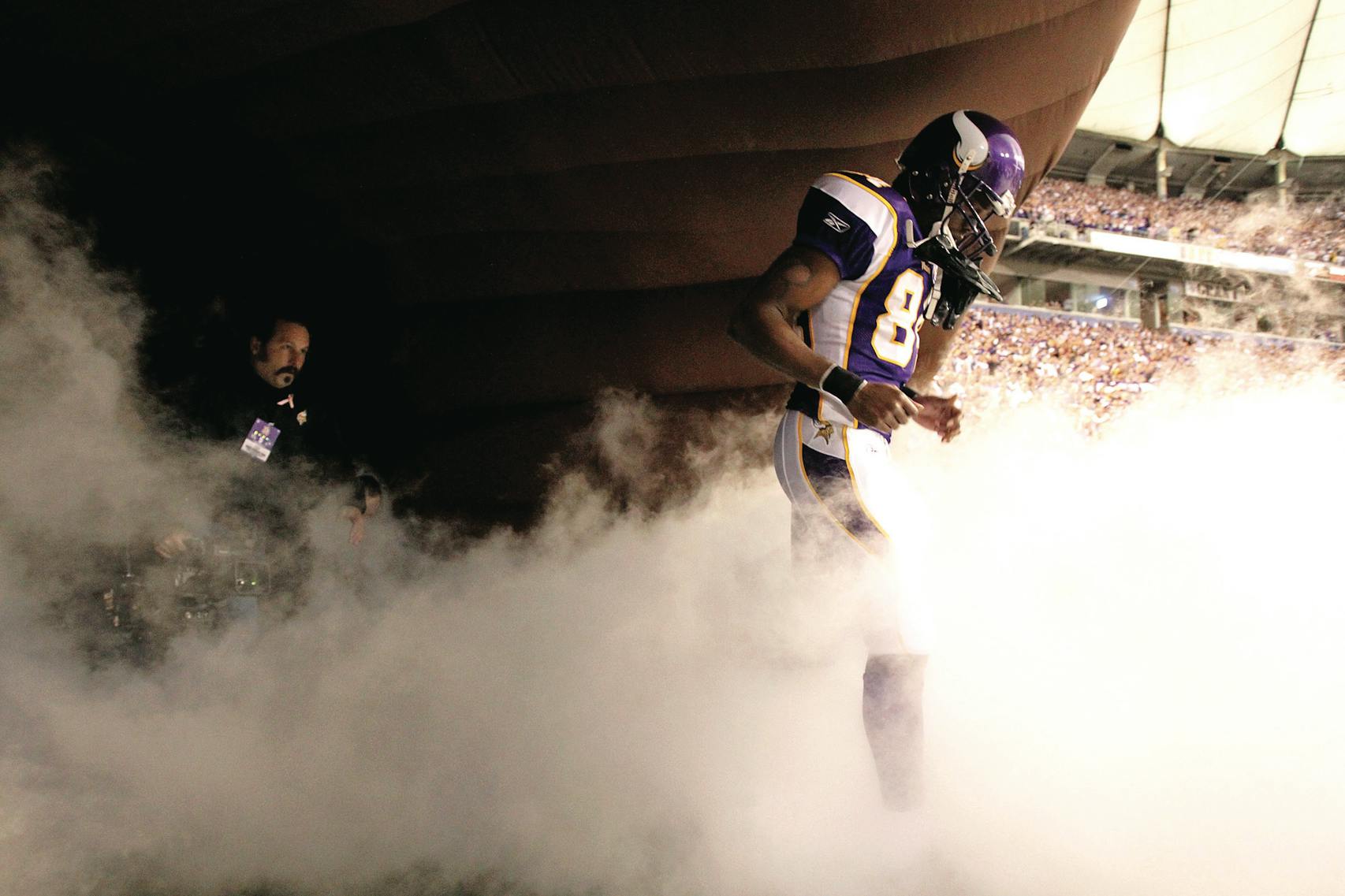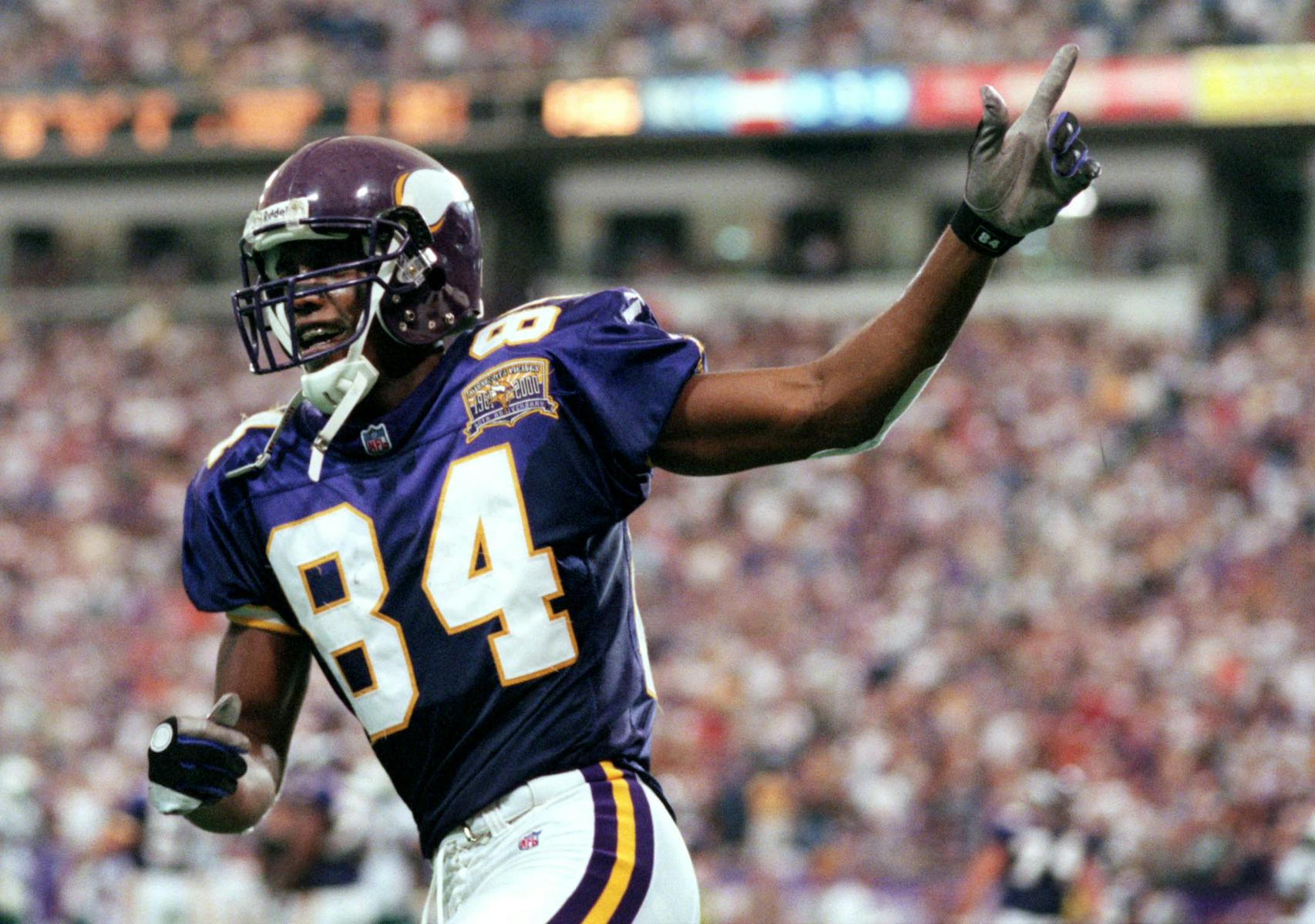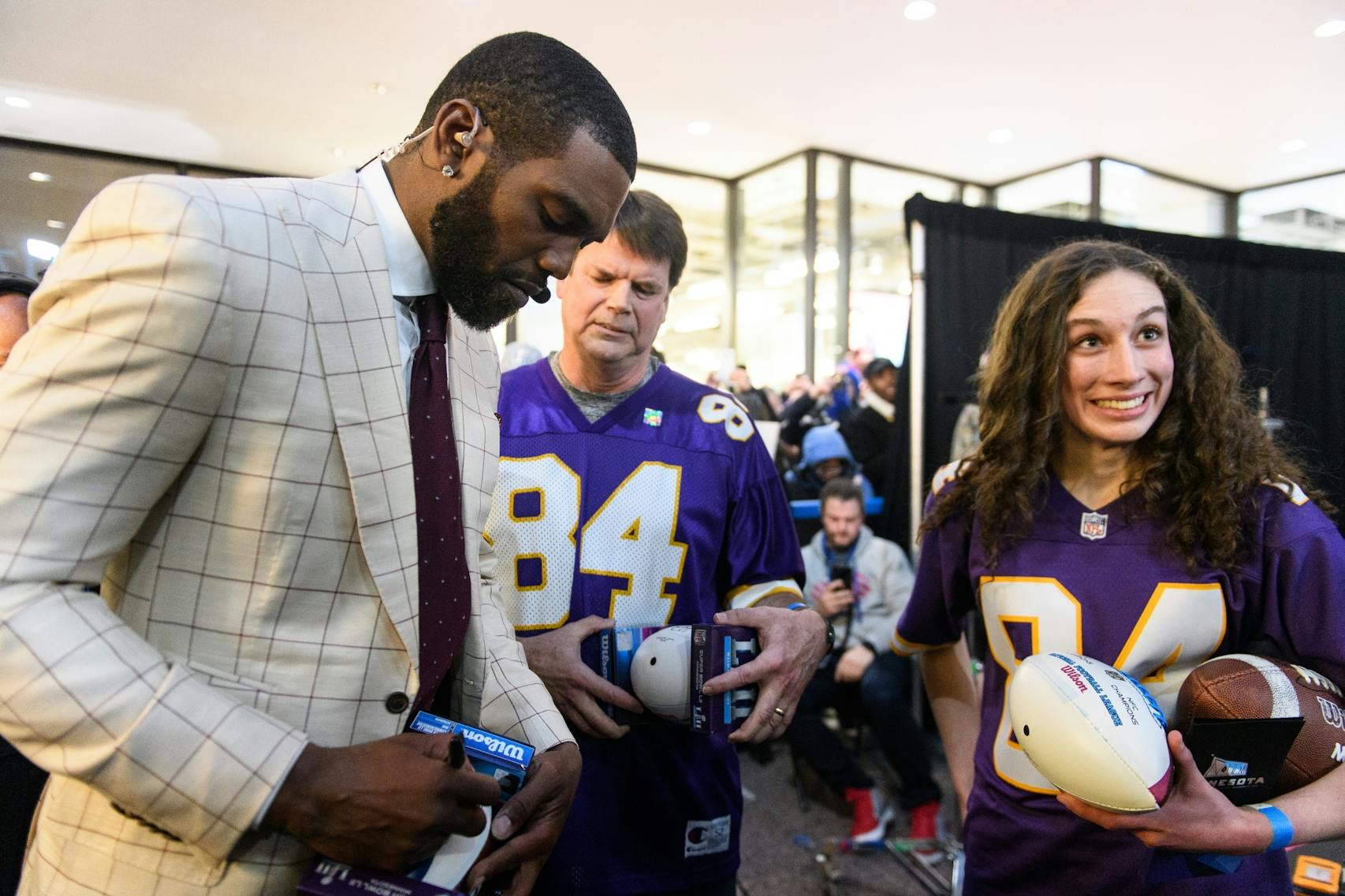By Mark Craig • Star Tribune
Text size comment1 share tweet email PrintmoreShare on: Share on LinkedIn Share on Google+ Share on Pinterest Copy shortlink: Purchase: Order Reprint Randy Moss stabs at the fancy desserts he's ordered while sitting in ESPN's production trailer just outside Kansas City's Arrowhead Stadium earlier this NFL season.
"I'm stuck for words when I look around at my life," the former Viking says between live shots as ESPN's infectiously energetic Monday Night Football analyst. "A poor country boy from little Rand, W.Va. Growing up some nights, no electricity, wondering, 'What am I going to eat?'"
The youngest of three children raised by a single mother, Moss now oozes fame and fortune amid a backdrop of awestruck fans that have been screaming his name since 1998, when his unique combination of size, speed and ball skills began their ascent toward rare NFL greatness and possible first-ballot entry into the Pro Football Hall of Fame on Saturday.
"When I first met my wife, I told her, 'I don't eat leftovers,'" Moss said. "I don't mean that in an arrogant way. I got money now. I've been blessed."
And now the day of reckoning as a first-ballot candidate has arrived for the mercurial, enigmatic "SuperFreak." Forty-eight selectors — including this writer — will meet in Bloomington to decide whether Moss can stiff-arm the stigma attached to his infamous "I play when I want to play" quote and become only the third receiver to earn first-ballot entry in the past 34 years.
With 156 receiving touchdowns — second only to Jerry Rice's 197 — Moss is adamant that he's a Hall of Famer who shouldn't have to settle for leftovers down the road.
"Few players have changed the game," Moss said. "Lawrence Taylor changed the game. I changed it. A few others changed it. I deserve first-ballot."
Since 1984, Steve Largent (1995) and Rice (2010) are the only receivers given first-ballot nods. Terrell Owens, who has 153 touchdowns, was denied twice and is a finalist again.
Moss said Owens' exclusion, "makes me question the criteria for the Hall of Fame." But Moss also bows to no one, saying he, not Rice, is the greatest receiver of all time.
"Hands-down, all day, shouldn't be no discussion," Moss said. "Jerry has the numbers. Jerry came in and played with two Hall of Fame quarterbacks. I didn't have no Hall of Famers with me. I had to grit and grind on my own to get everything I had. That's why I call myself the greatest. Nothing was given to me."
Moss did play four seasons with Hall of Fame receiver Cris Carter and caught 40 touchdown passes in 41 games with Tom Brady.
'You're not going to stop me'
Tony Dungy's eyes were opened when the 6-4, 215-pound Moss made his NFL debut by scoring twice on deep balls against a Buccaneers game plan designed to contain Moss.
"It was that way with Barry Sanders," Dungy said. "You could do everything right and it wouldn't matter. Double Randy, and he'd just jump over both guys."
Herm Edwards, Dungy's secondary coach, said he had to retrain his defensive backs to face Moss. The "Cover 2" scheme, with roots going back to Pittsburgh in the 1970s, is commonly called the "Tampa 2" because it had success in preventing deep completions and was responsible for the Vikings' only regular-season loss in 1998.
"Before Moss, deep balls hit between 42 and 45 yards," Edwards said. "With Randy, they'd hit at 50 because of his speed."
On a Monday night in Green Bay that year, Moss had five catches for 190 yards and two touchdowns. Six months later, the Packers became the first team in NFL history to open its draft by selecting three straight cornerbacks.
"I was like, 'You drafted [three] corners? Why? You're still not going to stop me,'" Moss said. "That was my mindset."
By Thanksgiving, Moss had eight touchdowns and was heading to Dallas to punish Cowboys owner Jerry Jones for letting character concerns prevent him from drafting Moss eighth overall.
"I didn't say nothing that week," Moss said. "But everyone knew what was going to happen when I got to Dallas."
Mike Zimmer was the Cowboys defensive backs coach at the time. Trying to simulate Moss' speed, Zimmer had the scout team receiver line up two yards offsides.
Moss caught three balls for 163 yards and three touchdowns. Two were deep balls early. The other was a one-step hitch when Randall Cunningham saw Moss singled with no help over the top.
"There were three defenders who had absolute angles on Randy on that little 1-yard pass," Brian Billick, then the Vikings offensive coordinator, said. "And they couldn't get there. That was maybe the biggest eye-opener for me that year."
'Greatest single talent'
Moss caught a rookie-record 17 touchdown passes to lead the league for the first of five times. Of the 25 modern-era receivers in the Hall of Fame, only Rice led the league in touchdowns more times (six).
In 1998, the Vikings went 15-1 and set the league scoring record with 556 points. In 2007, the Patriots went 16-0 and broke that mark with 589 points. Only Moss was on both teams.
"Randy was single-handedly the biggest difference-maker I have ever seen offensively," Hall of Famer Brett Favre said. "He is definitely a first-ballot Hall of Famer."
Moss ranks fourth in receiving yards (15,292) and averaged a touchdown every 6.3 catches. Rice averaged one every 7.8.
"He's the greatest deep-ball receiver I think that's ever played," Patriots coach Bill Belichick said. "Probably the smartest receiver I've ever coached."
Billick said Moss is the most talented receiver there has ever been and probably ever will be.
"We've seen big players," Billick added. "We've seen players who can really jump. We've seen players who have unbelievable speed. And we've had players with great hands. We've never had a player with all four."
So, what's the problem?
Raiders coach Jon Gruden scoffed a couple months back and said, "If you have any trouble getting Randy Moss in as a first-ballot Hall of Famer, then we need to consider the people who have votes."
But hurdles will include the consistency of Moss' effort, why the Vikings traded him at 27, his second year in Oakland, and 2010, when he was traded by the Patriots and released by the Vikings a month later.
Moss and his supporters argue that he only coasted occasionally on the backside of plays as a way to stay on the field while catching his breath from all his deep routes.
"I always said, 'Don't bring me off the field to rest,'" Moss said. "If I'm tired and the ball is ran away from me, I say, 'Hey, I'm drawing double coverage by just being on the field.'"
In 2001, Moss told Star Tribune columnist Sid Hartman, "I play when I want to play." Context of that conversation has been forgotten.
Hartman was doing a piece on Carter's role in Moss' success. Moss always hated the narrative that Carter and coach Denny Green were responsible for his success.
"I knew how I said it," Moss said in Kansas City this season. "It just didn't come across that way. You can't find a guy in 14 years to tell you I was a bad player or I was uncoachable. I respect this game. But I don't respect people that talk about the game that never played the game."
Before the 2005 season, Vikings owner Red McCombs ordered Moss' trade from his office in San Antonio.
"The trade was 100 percent my call," McCombs told the Star Tribune in 2015, citing some of Moss' poor behavior.
The move wasn't supported behind the scenes at Winter Park, nor the ownership group that was negotiating the purchase from McCombs at the time. Current owner Zygi Wilf said McCombs went against his word that he wouldn't trade Moss, and called it the biggest mistake in franchise history.
"That trade had nothing to do with football," Moss said. "It was political. That man [McCombs] didn't get his stadium. I think there were bad words exchanged with the politicians. And he said, 'OK, I'll take Randy from you.'"
Moss had eight touchdowns, 1,005 yards and a 16.8 average for the Raiders in 2005. Norv Turner was fired and replaced by Art Shell, who had been out of coaching for six years. Offensive coordinator Tom Walsh had been out of the NFL for 12 years, out of football for eight years and was running a bed & breakfast in Swan Valley, Idaho, where he served as mayor. After a 2-9 start, Walsh was demoted.
Rookie quarterback Andrew Walter went 2-6 and started only one more NFL game. Aaron Brooks went 0-8 and never played again. Moss had three touchdowns, but the Raiders threw only seven.
Belichick swooped in. Moss immediately set the single-season record for touchdown receptions (23). He played three-plus years for the Patriots. In 52 regular-season games as a Patriot, Moss caught 50 touchdown passes. In the two full seasons Brady was able to start, Moss led the league in touchdown catches both times.
"I've had my ups and down years," Moss said. "[2010], that wasn't even a year for me. The second year in Oakland was nothing. So two years for me were busts. Two out of 14. So I say this in a humbling way: I put my mark on this game. I really did."
Gruden's advice to the selection committee sums up how Moss' supporters feel.
"I've never met the perfect player, so everybody has faults," he said. "All I know is if you want to watch the greatest plays in the history of the world, Randy Moss is the star of that reel."



